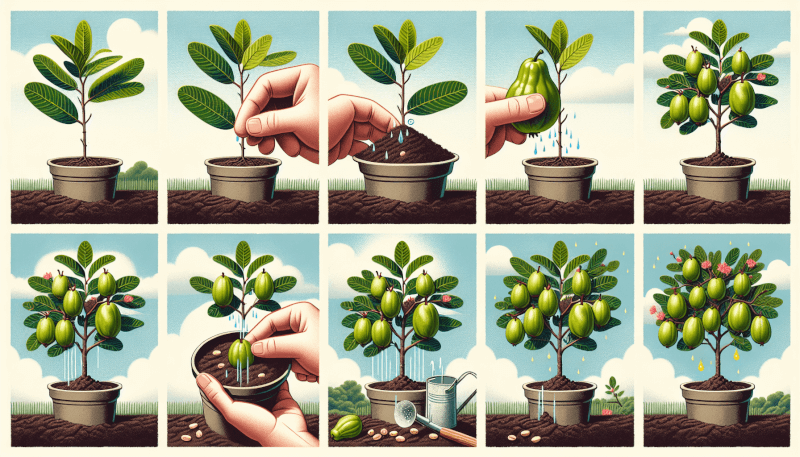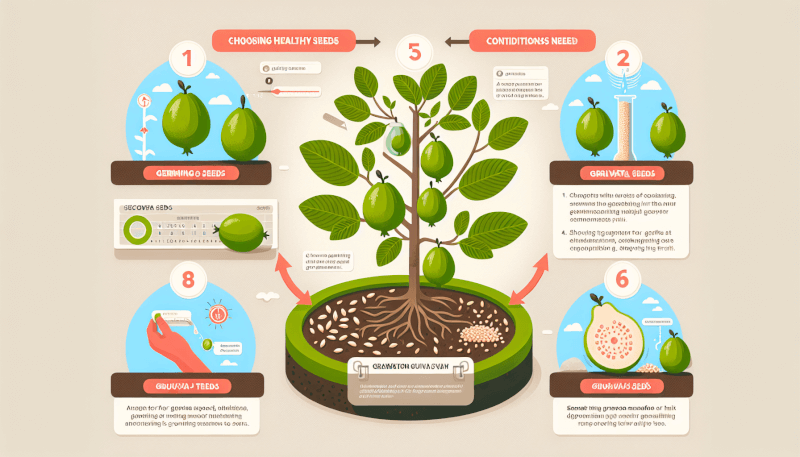👋 Click the mic button to talk to Alfred, the Todd's Seeds Gardening/Sprouting Expert – Feel free to ask him anything!
Ask Virtual Todd Anything - Click the Mic
Did you know that you can easily grow your very own guava tree from seeds? It’s a simple and rewarding process that can be done right in the comfort of your own home. In this article, we will guide you through the steps on how to successfully germinate guava seeds and watch them transform into beautiful and fruitful trees. So, if you’ve always wanted to try your hand at gardening or simply love the idea of growing your own tropical fruit, grab some guava seeds and let’s get started!
Selecting the Right Guava Seeds
Choosing the right guava variety is crucial when it comes to growing guava from seeds. There are various guava varieties available, each with its own unique characteristics and flavor profile. When selecting guava seeds, consider factors such as climate suitability, fruit size and taste preference, and disease resistance. Popular guava varieties include Red Malaysian, White Indian, and Pink Indonesian. Research different varieties and choose the one that best suits your needs and growing conditions.
Obtaining Fresh Guava Seeds
To ensure successful germination, it is essential to obtain fresh guava seeds. Fresh seeds have a higher chance of germinating compared to older or stored seeds. The best way to obtain fresh guava seeds is by collecting them from fully matured fruits. Choose ripe guavas with fully developed seeds. Cut open the guava and scoop out the seeds using a spoon. Rinse the seeds thoroughly to remove any pulp or flesh attached to them. This will help prevent mold or fungal growth during the germination process.

Checking the Seed Viability
Before proceeding with germination, it is important to check the viability of the guava seeds. This will give you an idea of how many seeds are likely to germinate successfully. To check the seed viability, take a handful of seeds and place them in a bowl of water. The viable seeds will sink to the bottom, while the non-viable or empty seeds will float. Discard the floating seeds as they are unlikely to germinate. By identifying the viable seeds, you can focus your efforts on germinating those with the highest chances of success.
Preparing the Germination Environment
Creating the optimal germination environment is crucial for the successful germination of guava seeds. By providing the right conditions, you can enhance the germination rate and ensure the healthy growth of your seedlings.
Gathering Materials
Before setting up the germination environment, gather all the necessary materials. You will need containers or pots with drainage holes, a germination medium such as peat moss or a seed starting mix, and a spray bottle for watering. Additionally, gather a water-soluble fertilizer and a source of artificial light if you plan to grow your seedlings indoors.
Creating a Germination Container
Choose a container or pot with drainage holes to prevent waterlogging and promote healthy root development. You can use seed trays, small pots, or even recycled containers as long as they have drainage holes. Make sure the container is clean to avoid any potential diseases or pests.
Preparing the Germination Medium
The germination medium plays a crucial role in providing the necessary nutrients, moisture, and aeration for the guava seeds to germinate. A mixture of peat moss and perlite or a commercial seed starting mix can be used as a germination medium. Fill the containers with the germination medium, leaving some space at the top for planting the seeds. Moisten the medium thoroughly before planting the guava seeds.

Seed Pretreatment
Some guava seeds require pretreatment to improve their germination rate. Pretreatment methods such as scarification and stratification can help break seed dormancy and promote germination.
Seed Scarification
Some guava seeds have a hard seed coat that can prevent water absorption and hinder germination. Scarification is a process that involves scratching or nicking the seed coat to break its dormancy. You can use sandpaper or a nail file to gently abrade the seed coat. Be careful not to damage the inner seed. After scarification, soak the seeds in water for a few hours before planting.
Seed Stratification
For certain guava varieties, stratification is necessary to simulate natural winter conditions and promote germination. Stratification involves exposing the seeds to cold temperatures to break their dormancy. To stratify guava seeds, place them in a sealed plastic bag with a damp paper towel or sphagnum moss. Store the bag in the refrigerator for 4-6 weeks. After stratification, remove the seeds from the refrigerator and allow them to warm up to room temperature before planting.
Initiating Germination
Once you have prepared the germination environment and pretreated the seeds if necessary, it’s time to initiate the germination process.
Soaking Guava Seeds in Water
Before planting the seeds, soak them in water for 24-48 hours. This helps soften the seed coat and promote water absorption, which is essential for germination. Fill a container with water and place the seeds in it. Make sure all the seeds are submerged. After soaking, remove the seeds from the water and pat them dry gently before planting.
Coating Seeds with Salt Solution
Another method to enhance germination is by coating the guava seeds with a salt solution. Dissolve one teaspoon of salt in one cup of warm water. Stir the solution until the salt is completely dissolved. Place the guava seeds in the salt solution and let them soak for 10-15 minutes. This salt solution helps to disinfect the seeds and reduce the chances of fungal or bacterial infections.
Temperature and Moisture Considerations
Temperature and moisture play crucial roles in seed germination. Guava seeds require a warm environment with temperatures between 75-85°F (24-29°C) for optimum germination. Maintain a consistently moist but not waterlogged germination medium. Avoid overwatering, as it can lead to seed rot or fungal issues. Place the germination containers in a warm and well-lit area, away from direct sunlight.

Planting Guava Seeds
Once the seeds have undergone pretreatment and the germination environment is ready, it’s time to plant the guava seeds.
Choosing Suitable Pots
Select pots or containers that are spacious enough to accommodate the growing seedlings. Use pots with drainage holes to prevent waterlogging. The size of the pot will depend on the number of seeds you are germinating. Leave enough space between the seeds to prevent overcrowding once they start growing.
Filling the Pots with Growing Medium
Fill the pots with the prepared germination medium, leaving some space at the top. Gently tap the pots to settle the medium and eliminate any air pockets. Make a small indentation in the center of the pot using your finger or a pencil. This is where you will place the guava seed.
Properly Planting the Guava Seeds
Place a single guava seed in each indentation, ensuring they are not buried too deep. Lightly cover the seed with a thin layer of the germination medium. The goal is to provide enough coverage for the seed to remain in place but still allow it to receive light when germinating.
Caring for Germinating Guava Seeds
Proper care is essential to ensure the healthy growth of germinating guava seeds. Pay attention to their light, water, and protection needs.
Providing Optimal Lighting Conditions
Place the germination containers in a well-lit area where the seedlings can receive bright, indirect sunlight. If you are growing the seedlings indoors, consider using artificial grow lights to provide sufficient light. Keep the lights on for 12-14 hours a day to simulate natural daylight.
Watering and Maintaining Moisture Levels
Water the guava seedlings regularly to maintain moist but not waterlogged conditions. Use a spray bottle or a gentle watering can to avoid disturbing the seedlings. The germination medium should always feel slightly damp to the touch. Monitor the moisture levels closely and adjust watering accordingly.
Protecting Germinating Seeds from Pests and Diseases
Seedlings are vulnerable to pests and diseases, so it’s important to protect them. Keep a close eye for any signs of pest infestation or disease, such as wilting, discoloration, or abnormal growth. If necessary, treat the seedlings with a suitable organic pest control solution or consult a gardening professional for guidance.

Transplanting Germinated Seedlings
Once the guava seedlings have grown and developed their first set of true leaves, it’s time to transplant them into larger containers or the garden.
Monitoring Seedling Growth
As the seedlings grow, they will develop several sets of leaves and start to establish a stronger root system. Monitor their growth regularly to ensure they are ready for transplanting. Once the seedlings are around 6-8 inches tall and have developed 3-4 pairs of true leaves, it is a good time to transplant them.
Preparing the Transplanting Area
If transplanting outdoors, choose a sunny location with well-draining soil. Prepare the planting area by removing any weeds or unwanted vegetation. Dig a hole slightly larger than the root ball of the seedling to facilitate root growth.
Carefully Transplanting Guava Seedlings
Gently remove the seedlings from their containers, being careful not to disturb the roots too much. Place the seedling in the planting hole, making sure that the top of the root ball is level with or slightly above the soil surface. Backfill the hole and lightly firm the soil around the seedling. Water the transplanted seedlings thoroughly to help them establish in their new location.
Post-Germination Care
Once the guava seedlings have been transplanted, they require ongoing care to ensure healthy growth and fruit production.
Fertilizing Guava Seedlings
Provide your guava seedlings with a balanced water-soluble fertilizer to promote healthy growth. Follow the manufacturer’s instructions for application rates and frequency. Organically derived fertilizers are also a good option for those who prefer organic gardening practices.
Pruning and Shaping Seedlings
Regular pruning is essential for shaping and maintaining the desired form of guava trees. Prune the seedlings to remove any dead or diseased branches, as well as to encourage branching and create a well-structured canopy. Be cautious not to remove too much foliage, as it can affect the growth and fruiting potential of the plant.
Providing Adequate Sunlight and Water
Guava trees thrive in full sun, so ensure that your seedlings receive at least 6-8 hours of direct sunlight each day. Water the seedlings regularly, keeping the soil consistently moist but not waterlogged. Adjust watering frequency depending on the weather conditions and the moisture needs of the plants.

Troubleshooting Germination Issues
Despite careful care, germination issues may still arise. Here are some common issues and ways to address them:
Addressing Slow or Failed Germination
If the guava seeds are taking longer than expected to germinate or have failed to germinate at all, there may be several causes. Ensure that the seeds were fresh and viable to begin with. Check the moisture levels and temperature in the germination environment. Adjust the conditions as needed to create a more favorable environment for germination. If necessary, try different pretreatment methods or purchase fresh seeds from a reputable source.
Dealing with Mold or Fungal Growth
Mold or fungal growth can be a common problem during the germination process. To prevent mold, ensure that the germination medium is moist but not overly wet. Increase ventilation by opening windows or placing a small fan nearby. If mold does appear, gently remove the affected areas and adjust the watering routine to prevent further fungal growth.
Overcoming Seedling Damages
Seedlings may be susceptible to various damages, such as pest attacks or accidental breakage. Protect your seedlings from pests by implementing organic pest control measures and regularly inspecting for signs of damage. If a seedling is accidentally damaged or broken, carefully trim the affected area and provide proper support to help it recover.
Harvesting Guava Fruits
After months of patient care and nurturing, it’s finally time to harvest your guava fruits. Harvesting guavas at the right time ensures optimal flavor and texture.
Patience and Time
Guava fruits typically take several months to reach maturity, so patience is key. Monitor the fruits closely as they develop and wait until they are fully ripe before harvesting. A ripe guava will have a slight give when gently squeezed.
Recognizing Fruit Maturity
To determine if a guava fruit is ready for harvest, examine its size, color, and aroma. Depending on the variety, ripe guavas may range in color from green to yellow, pink, or red. The aroma of a ripe guava should be sweet and fragrant.
Harvesting Techniques
To harvest guava fruits, gently twist them at the base until they detach from the tree. Be careful not to damage the fruit or the tree during the process. Handle the harvested fruits with care to avoid bruising. Once harvested, guavas can be enjoyed fresh or used in various culinary preparations.
By following these comprehensive steps, you can successfully germinate and grow guava plants from seeds. With proper care and attention, you will soon be rewarded with delicious guava fruits straight from your own garden. Happy gardening!